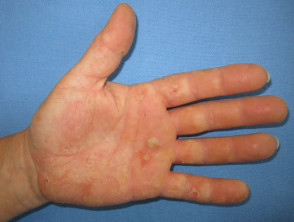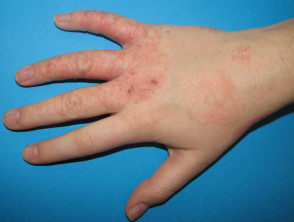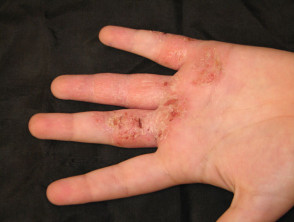Introduction
Childcare work is a major employer worldwide. The number of people employed in this sector is expected to expand, especially in developing countries where more women have entered the workforce and are choosing childcare centres over babysitters or childcare from relatives. However, it is considered to be an occupation at high risk for work-related skin disorders.
Why childcare workers are at risk for occupational skin disorders
Factors that put childcare workers at risk of work-related skin conditions include:
- A fast-paced and often stressful work environment
- Globally, a lack of proper oversight and protocol, with work conditions primarily dictated by local owners
- Everyday operation issues taking precedence over health and safety issues for childcare workers
- A preponderance of low-paid, part-time, or transient staff with low education and socioeconomic backgrounds
- Potential exposure to a wide variety of irritants and allergens, including cleaning agents and disinfectants, art and other classroom-related supplies, and latex gloves
- Wetwork, where the skin is frequently exposed to water.
Understanding occupational skin disorders
Occupational skin diseases are a variety of dermatological conditions that are the result of — or made worse by — the nature of the patient’s job. It has a large economic impact in the form of missed days of work and may lead to a change of profession if the condition becomes severe. Occupational dermatoses occur when the protective barrier of the skin is breached by mechanical, chemical, or biological means, including cuts and abrasions, exposure to irritants and allergens or contact with viruses or bacteria. In developed countries, tighter regulation and a greater emphasis on worker safety have been credited with reducing the rate of occupational skin disorders.
Occupational skin disorders associated with childcare workers
There are a number of occupational skin disorders related to childcare workers, including:
Allergic and irritant contact dermatitis
Contact dermatitis is the most frequently occurring skin problem in child care workers.
- Contact allergic dermatitis refers to a Type IV delayed hypersensitivity reaction that only affects a sensitive individual, whereas irritant contact dermatitis is an inflammatory response to a single or repetitive injury to the skin.
- Common causes include wet work, disinfectants, art supplies, and other chemicals.
- Patients present with redness, vesicles or papules, itching, pain, burning sensation, oedema and fissures, or scaling.
Hand dermatitis
Mechanical injuries
These are another common risk for child care workers.
- Common culprits include scissors, paper cuts, and minor cuts/abrasions from other classroom tools.
- Injury breaches the skin and makes it more vulnerable to subsequent secondary bacterial or viral infections.
- To reduce the risk of infections, first aid should be prompt and include cleaning the wound and keeping the wound covered until the skin has healed.
Bite injuries
Due to contact with babies, toddlers, and preschoolers, human bite injuries may occur.
- Transmission of human immunodeficiency virus (HIV), hepatitis B, or a similar disease is rare.
- Wounds should be washed with soap and water, and the wound covered until healed.
- Signs and symptoms of an infection include pus, foul-smelling drainage, redness or warmth, swelling, tenderness/pain, or fever.
- Tetanus, diphtheria, and pertussis vaccine (TDP vaccine) should be considered if not already up to date.
Head lice infestation
Head lice are a frequent and ongoing problem in the childcare setting.
- Head lice are highly contagious and easily transmitted through skin to skin contact or sharing/contact with personal items like combs or hats.
- An infestation is not considered to be dangerous.
- Head lice cause intense itching and are diagnosed by seeing the live lice or brown egg cases (nits) adherent to hair shafts close to the scalp surface.
- Blood spots may be seen behind the ears or elsewhere on the scalp.
- Treatments include medicated insecticide shampoos and specialized combs for removing nits from the hair.
Sun exposure
Sun exposure tends to be overlooked but can represent a significant risk over time for childcare workers.
- Sun exposure usually occurs during recess or outdoor play time.
- Exposure increases the risk of skin ageing and for basal and squamous cell carcinoma and melanoma
- This risk can be reduced by use of hats, sun protective clothing, sunscreens, and the provision of shaded areas from which to supervise children’s outdoor time.
Workplace assessment
An effective workplace assessment should include:
- Physical environment (including lighting, handrails, washing/cleaning facilities, etc.)
- Protocols for performing various childcare tasks, such as changing diapers or food preparation
- Provision for, and education, on proper handwashing techniques and infection control.
Personal protective equipment
Gloves for hand protection are the most frequently used form of personal protective equipment.
- Glove use reduces exposure to allergens and irritants and protects hands during wet work.
- Gloves can themselves become allergens if they contain latex or certain rubber accelerants; latex-free gloves should be used preferentially.
- Education on proper donning, disposal, and use of gloves is essential.
Hand care advice for childcare workers
Advice for protecting childcare workers includes:
- Use the right type of glove for the right job
- Practice proper handwashing techniques, and use alcohol-based gels when appropriate
- Use lotions and creams to keep skin moisturised
- Recognition of occupational dermatoses and knowledge of when to seek treatment for them.
Diagnosis and treatment of occupational skin disorders
Diagnosis of an occupational skin disorder should be based on:
- Physical examination, including the areas affected and specific signs and symptoms
- Patient medical and personal history, including a history of allergies/atopy (especially atopic eczema)
- Occupational assessment, including the nature of the patient’s work, sources of workplace exposure, safety protocols at the job site, and the duration of employee’s stay on a particular job
- Skin patch testing
- Skin biopsy if indicated.
Management of occupational skin disease may include:
- Avoidance of the irritant or allergen
- Basic first aid/use of antibiotics for mechanical injuries or bites
- Use of mild soap substitutes or alcohol-based hand gels/sanitisers
- Use of topical and systemic corticosteroids
- Use of insecticides or other topical treatment for head lice
- Referral to a dermatologist if skin problems persists or resist simple treatments.


